|
Performance Steps
|
|
Note. The M249 is
available with old and new style
barrels. Diagrams used here show the
new-style barrel.
|
|
1. Clear the M249 machine gun.
|
a.
Move the safety to the fire
position.
|
b.
With your right hand, palm
up, pull the cocking handle to the
rear and lock the bolt to the rear.
|
c.
Hold the cocking handle to
the rear and move the safety to the
safe position. Push the cocking handle
forward to the locked position. Place
weapon on safe.
|
d.
Push the cocking handle
forward to its locked position (you
should hear a click).
|
e.
Raise the cover and feed
mechanism assembly. To check for
brass, links, or ammunition-
|
(1)
Check the feed pawl
assembly under the feed cover.
|
(2)
Check the feed tray
assembly.
|
(3)
Lift the feed tray assembly
and inspect the chamber.
|
(4)
Check the space between the
bolt assembly and chamber.
|
(5)
Insert two fingers in the
magazine well and feel for brass or
ammunition.
|
f.
Close the cover and feed
mechanism assembly. Move the safety to
the fire position.
|
g.
Pull the cocking handle to
the rear, press the trigger, and ease
the bolt forward.
|
|
2. Disassemble the M249 machine gun.
|
|
WARNING:
Ensure bolt
is in forward position before
removing drive spring, return rod,
and transfer mechanism assembly
|
a.
Remove the drive spring,
return rod, and transfer mechanism
assembly.
|
(1)
Raise the cover assembly.
Pull the upper retaining pin at the
rear of the receiver to the left. Let
the butt pivot downward so the rear
opening of the receiver is clear
(figure 071-312-4025-1).
|
|
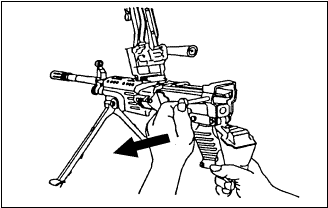
Figure 071-312-4025-1.
Rear opening of the receiver
|
|
Note. The upper and lower retaining pins in the rear of the
receiver are captured pins. Do not try
to remove them completely during
disassembly.
|
(2)
Hold the weapon with one
hand on the buttstock. At the same
time, push in and upward on the rear
end of return rod and transfer
mechanism assembly with thumb of other
hand to release it from positioning
groove. Withdraw return rod and
transfer mechanism assembly and spring
(figure 071-312-4025-2).
|
|
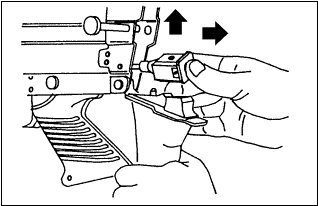
Figure 071-312-4025-2.
Removal of the return rod and transfer
mechanism assembly
|
(3)
Separate the spring from
the return rod and transfer mechanism
assembly (figure 071-312-4025-3).
|
|
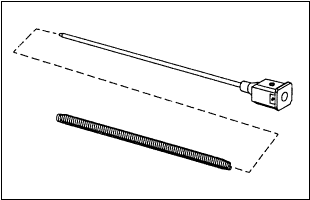
Figure 071-312-4025-3.
Removal of the spring
|
b.
Remove the operating rod,
slide assembly, and bolt assembly.
|
(1)
Pull the cocking handle to
the rear to move operating rod, slide
assembly, and bolt assembly out the
rear of the receiver (figure 071-312-4025-4).
|
|
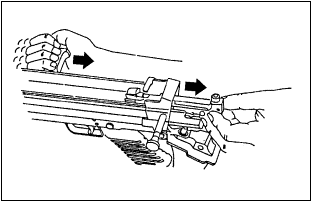
Figure 071-312-4025-4.
Removal of the operating rod, slide assembly, and bolt assembly
|
(2)
Rotate the bolt clockwise
to disengage the lug. Remove the bolt
from the slide assembly. Separate the
piston from the slide assembly by
pressing the rearmost retaining pin to
the left and lifting the piston off
the slide assembly (figure 071-312-4025-5).
|
|
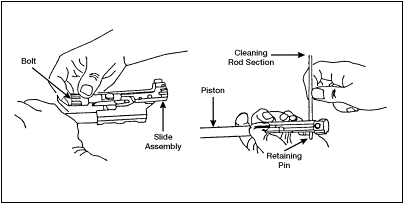
Figure 071-312-4025-5.
Removal of the bolt and piston
|
c.
Remove the heat shield.
Hold the weapon with one hand. With
the other hand, grasp the heat shield
just forward of the barrel handle, and
lift it off the barrel (figure 071-312-4025-6).
|
|
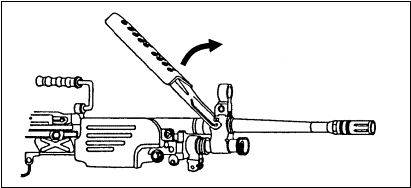
Figure 071-312-4025-6.
Removal of the heat shield
|
d.
Remove the barrel (figure 071-312-4025-7).
|
(1)
Ensure the folding handle
on the new style barrel is in carrying
(up) position.
|
(2)
Depress the barrel locking
lever with your left hand. Grasp and
lift the carrying handle with your
right hand. Push the barrel forward.
|
|
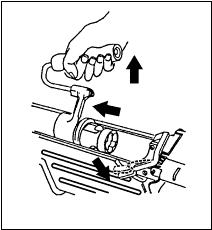
Figure
071-312-4025-7.
Remove the barrel
|
e.
Remove the handguard
(figure 071-312-4025-8)
|
(1)
Push the handguard
retaining pin to the left using a
section of the cleaning rod.
|
(2)
Pull downward and remove
the handguard.
|
|
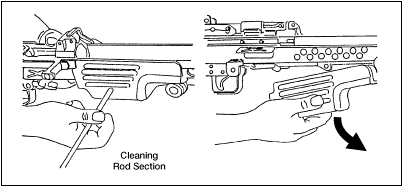
Figure 071-312-4025-8.
Remove the handguard
|
f.
Remove the gas regulator.
|
(1)
Position the gas collar so
you can insert the scraper assembly
into the notch in the front left of
the gas block.
|
(2)
Insert the tip of the
scraper assembly in the notch; hold
the scraper firmly in position (figure
071-312-4025-9).
|
|
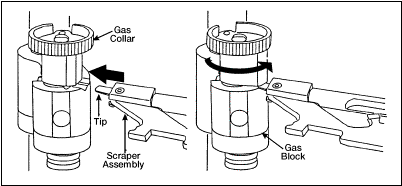
Figure 071-312-4025-9.
Insertion of the scraper assembly
|
(3)
Turn the collar
counterclockwise and remove it (figure
071-312-4025-10).
|
(4)
Remove the gas regulator
from the gas block (figure 071-312-4025-10).
|
|
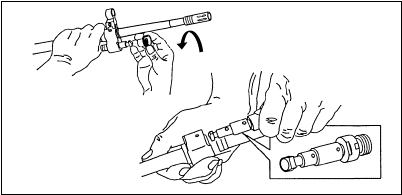
Figure 071-312-4025-10.
Removal of the gas regulator from the
gas block
|
g.
Remove the buttstock and
buffer assembly.
|
|
Note. The upper and lower retaining pins in the rear of the
receiver are captured pins. Do not try
to remove them completely during
disassembly.
|
(1)
Using a section of the
cleaning rod, push the lowermost
retaining pin to the left.
|
(2)
While supporting the
trigger mechanism with one hand, use
the other to pull the buttstock and
buffer assembly rearward and remove it
(figure 071-312-4025-11).
|
|
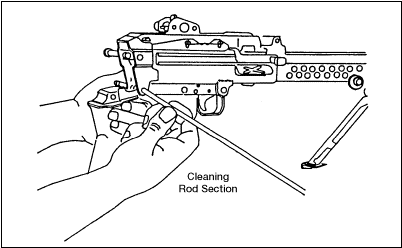
Figure 071-312-4025-11.
Removal of the buttstock and buffer
assembly
|
h.
Remove the trigger
mechanism by pulling rearward and down
(figure 071-312-4025-12).
|
|
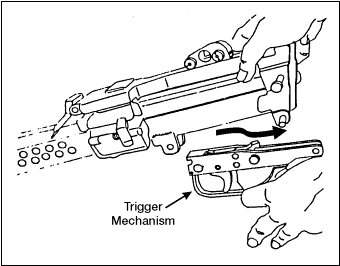
Figure 071-312-4025-12.
Removal of the trigger mechanism
|
i.
Remove the gas cylinder.
|
(1)
Turn the gas cylinder to
the left or right to release the
locking spring.
|
(2)
Pull the gas cylinder
forward to remove it (figure 071-312-4025-13).
|
|
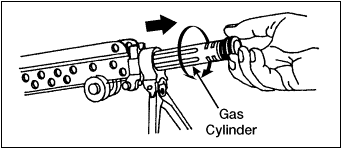
Figure 071-312-4025-13.
Removal of the gas cylinder
|
j.
Remove the bipod. The bipod
should slip off the receiver easily.
If it does not, turn the bipod left or
right to loosen any dirt or corrosion
(figure 071-312-4025‑14).
|
|
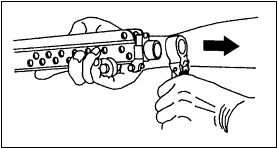
Figure 071-312-4025-14.
Removal of the bipod
|
|
3. Clean the M249.
|
|
WARNING:
Do not use
gasoline, kerosene, hydraulic oil,
benzene, benzol, high-pressure
water, steam, or compressed air for
cleaning
|
|
Note. Do not use abrasives to clean the bore, piston, gas
cylinder, or gas regulator.
|
a.
Clean the bore and chamber
using a bore brush, a chamber brush,
CLP, and fresh swabs..
|
b.
Clean the gas regulator
using the scraper. Do not use CLP on
the collar, gas block, or body.
|
(1)
Clean the gas vent hole
(figure 071-312-4025-15).
|
|
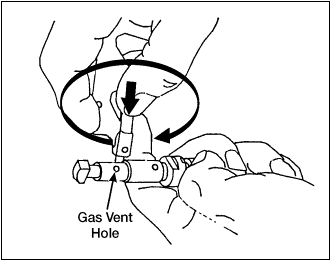
Figure 071-312-4025-15.
Cleaning the gas vent hole
|
(2)
Clean the central hole of
the gas regulator with the appropriate
part of the scraper by turning the
scraper clockwise and pushing it
inward toward the bottom of the
housing (figure 071-312-4025-16).
|
|
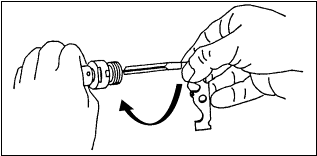
Figure 071-312-4025-16.
Cleaning the central hole
|
(3)
Clean the two grooves of
the regulator body using the
protruding tips of the scraper (figure
071-312-4025-17).
|
|
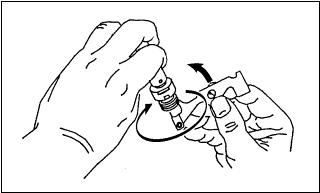
Figure 071-312-4025-17.
Cleaning the grooves of the regulator
body
|
c.
Clean the gas cylinder and
piston using the scraper. Do not use
CLP on the gas cylinder or on the
piston.
|
(1)
Clean the front interior of
the gas cylinder (repositioned in
receiver with bipod in place) by
inserting and turning the flat side of
the scraper in a full 360-degree
circular motion (figure 071-312-4025-18).
|
|
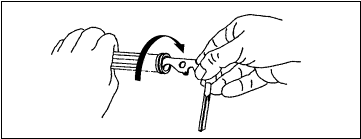
Figure 071-312-4025-18.
Cleaning the gas cylinder’s front
interior
|
(2)
Clean the internal grooves
on the front side of the gas cylinder
as previously described (using the
protruding tips of the scraper), but
insert the scraper farther into the
gas cylinder (figure 071-312-4025-19).
|
|
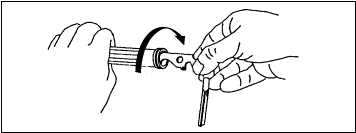
Figure 071-312-4025-19.
Cleaning the gas cylinder’s internal
grooves
|
(3)
Clean the three grooves of
the piston using a full, 360-degree
circular motion (figure 071-312-4025-20).
|
|
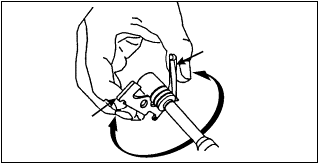
Figure 071-312-4025-20.
Cleaning the grooves of the piston
|
(4)
Clean the hole in the front
of the piston by inserting and turning
the flat side of the scraper in a full
360-degree circular motion (figure 071-312-4025‑21).
|
|
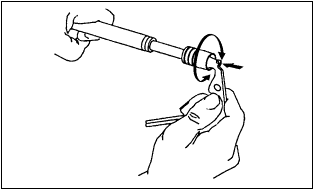
Figure 071-312-4025-21.
Cleaning the hole in the piston
|
d.
Remove carbon and dirt from
all other parts of the weapon using
CLP and a wiping rag.
|
e.
Clean ammunition boxes with
a brush and clean dry wiping rag.
|
f.
Clean ammunition with a
clean dry wiping rag.
|
|
4. Inspect the M249 machine gun.
|
a.
Inspect the bore and
chamber for chips and pitting.
|
b.
Check the front sight for
looseness.
|
c.
Inspect the flash
suppressor (old style barrel) or
compensator (new style barrel), the
barrel extension, and the barrel
release for cracks, dents, burrs, or
other damage.
|
d.
Check the cover assembly
for smooth operation, spring tension,
bent parts, and excessive wear.
|
e.
Check the cocking assembly
for free movement and for bent or
cracked parts.
|
f.
Check the rails for
excessive wear, burrs, and chips.
|
g.
Check the barrel locking
latch and cover detect springs for
spring tension.
|
h.
Check for broken pistol
grip and chipped or cracked trigger
housing holding lug.
|
i.
Check the tripping lever
and the seat for burrs, cracks, chips,
or wear.
|
j.
Check the cocking action by
pushing back on the tripping lever;
the sear should rise. Pull the
trigger; the sear should lower.
|
k.
Check the safety function.
Push the safety to the right (RED BAND
NOT VISIBLE). Pull the trigger; the
sear will not lower. Push the safety
to the left (RED BAND VISIBLE). Pull
the trigger again; the sear will
lower.
|
l.
Check the slide assembly,
bolt assembly, piston assembly, and
return rod and transfer mechanism
assembly for burrs, cracks, and broken
pins. Push down on roller of slide
assembly to ensure it retracts. Check
the driving spring for broken strands.
|
m.
Check bipod legs for
correct operation.
|
n.
Check the rear sight
assembly for serviceability.
|
o.
Check the ammunition box
for damage. Make sure the box latch
will engage the receiver dovetail.
|
p.
Inspect ammunition.
|
(1)
Check for damaged,
corroded, or loose bullets.
|
(2)
Check for damaged links.
|
(3)
Report to your squad leader
or NCOIC any deficiencies you cannot
correct.
|
|
5. Lubricate the M249.
|
|
Note. Use only CLP on the M249.
|
a.
Lubricate exposed metal
parts and all moving parts with a
light coat of CLP.
|
b.
Do not lubricate the gas
regulator hole in the barrel or the
gas regulator itself.
|
|
6. Assemble the M249.
|
a.
Replace the bipod and gas
cylinder.
|
(1)
Place the bipod on the
receiver.
|
(2)
Push the gas cylinder
through the bipod yoke into the
receiver.
|
(3)
Push the cylinder to the
rear while countering the pressure of
the locking spring and guiding the end
of the cylinder into the receiver with
the other hand applying downward
pressure. When you have fully inserted
the gas cylinder, rotate it until the
spring clicks into place in the recess
at the rear of cylinder (figure 071-312-4025-22).
|
|
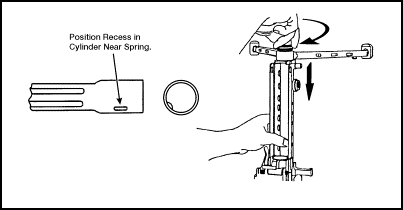
Figure
071-312-4025-22.
Replacement of the bipod and gas
cylinder
|
b.
Replace the handguard.
|
(1)
Stow the cleaning equipment
in the handguard.
|
(2)
Place the handguard onto
the receiver and slide it backward
until it stops.
|
(3)
Using a cleaning rod
section, push the handguard retaining
pin to the right. This locks the
handguard into position (figure 071-312-4025-23).
|
|
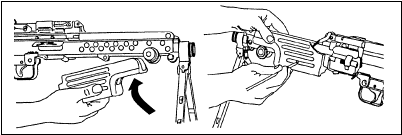
Figure 071-312-4025-23.
Replacement of the handguard
|
(4)
Pull downward on the
handguard to ensure it locks into
position.
|
c.
Replace the gas regulator.
|
(1)
Insert the gas regulator
into the lower end of the hole in the
gas block. Align the notch on the gas
regulator body with the notch in the
gas block (figure 071-312-4025-24).
|
|
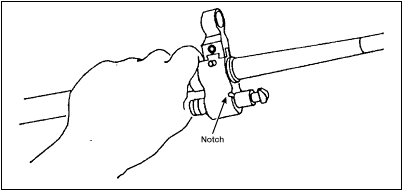
Figure 071-312-4025-24.
Replacement of the gas regulator
|
(2)
With the gas regulator
installed and supported on a firm
surface, place the gas collar on the
protruding end of the gas regulator.
Rotate the gas collar until it slips
in place. To lock the gas regulator in
place, press it in and rotate it
(figure 071-312-4025-25).
|
|
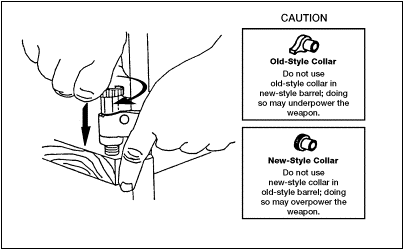
Figure 071-312-4025-25.
Replacement of the gas collar
|
d.
Replace the barrel.
|
(1)
Depress the barrel locking
lever with your left hand (figure 071-312-4025‑26).
|
|

Figure 071-312-4025-26.
Replacement of the barrel
|
(2)
Hold the carrying handle
with your right hand; pull the barrel
rearward into the receiver. Push the
carrying handle downward and release
the barrel locking lever. Check to
ensure the barrel locks into position.
|
|
e.
Replace the trigger
mechanism (figure 071-312-4025-27).
|
|

Figure 071-312-4025-27.
Replacement of trigger mechanism
|
(1)
Pull the retaining pin to
the left side of the receiver.
|
(2)
Align the trigger mechanism
with the slot on the bottom of the
receiver. To hold the trigger
mechanism in place, push the lower
retaining pin into the right side hole
on the rear of the trigger mechanism
assembly.
|
f.
Replace the buttstock and
shoulder assembly (figure 071-312-4025-28).
Support the trigger mechanism with
your left hand. Align the lower hole
in buttstock and buffer assembly with
the rear hole in the trigger
mechanism. Push the lower retaining
pin to the right.
|
|

Figure 071-312-4025-28.
Replacement of the buttstock and
shoulder assembly
|
g.
Replace the operating rod,
slide assembly, and bolt assembly.
|
(1)
Secure the slide assembly
to the piston by pushing the retaining
pin from the left to the right. Place
the firing pin spring on the firing
pin (figure 071-312-4025-29).
|
|

Figure 071-312-4025-29.
Attachment of the slide assembly to
the piston
|
(2)
Put the bolt assembly into
the slide assembly. Press in to
compress the firing pin spring. Rotate
the bolt and hook its driving lug into
the slide assembly (figure 071-312-4025-30).
|
|

Figure 071-312-4025-30.
Attachment of the bolt assembly to the
slide assembly
|
(3)
Put the assembled parts
into the receiver with the feed cover
open. Align and place the bolt lugs;
slide the cutouts carefully onto the
receiver rails. Press the trigger and
at the same time, push the parts all
the way forward (figure 071-312-4025-31).
|
|

Figure 071-312-4025-31.
Replacement of the operating rod,
slide assembly, and bolt assembly
|
h.
Replace the spring, return
rod, and transfer mechanism assembly.
|
(1)
Put the slide spring on the
return rod and transfer mechanism
assembly (figure 071-312-4025-32).
|
|

Figure 071-312-4025-32.
Replacement of the spring
|
(2)
Ensure that the headed end
of the vertical pin in the transfer
mechanism assembly points upward (on
top of the transfer mechanism
assembly) (figure 071-312-4025-33).
|
|

Figure 071-312-4025-33.
Replacement of the return rod and transfer mechanism assembly
|
(3)
Hold the pistol grip with
one hand. With the other hand, push
the return rod and transfer mechanism
assembly into its housing in the
piston. Press inward and downward on
the rear of the assembly until its two
lugs move into the receiver grooves.
|
i.
Pivot the buttstock and
buffer assembly upward into position.
Push the retaining pin to the right,
and close the cover assembly (figure 071-312-4025-34).
|
|

Figure 071-312-4025-34.
Replacement of buttstock and buffer
assembly
|
j.
Replace the heat shield
assembly (figure 071-312-4025-35).
|
|

Figure 071-312-4025-35.
Replacement of the heat shield
assembly
|
(1)
Hook the metal extensions
of the heat shield assembly under the
front sight pins (new style barrel)
with the spring clips down on top of
the barrel.
|
|
Note. Although old style barrels do not have protruding front
sight pins, you can still install heat
shield assemblies on them.
|
(2)
Apply downward pressure and
snap the heat shield onto the barrel.
Be careful not to pinch yourself.
|
|
7. Perform a function check to ensure you have
assembled the weapon correctly.
|